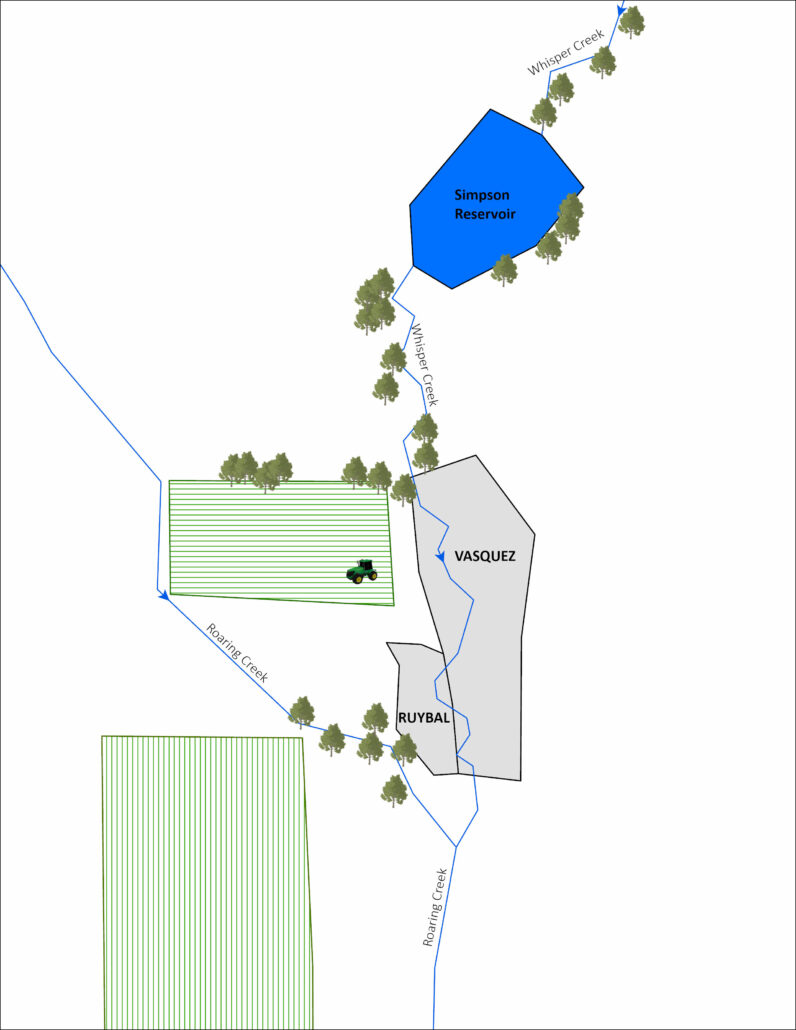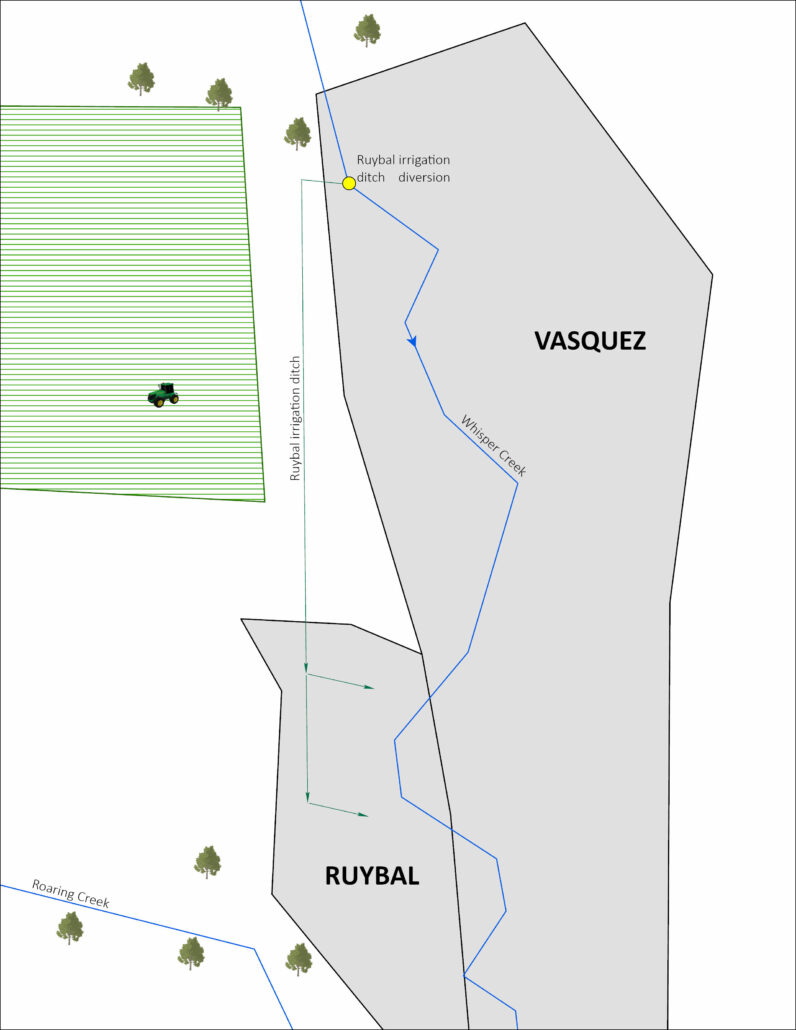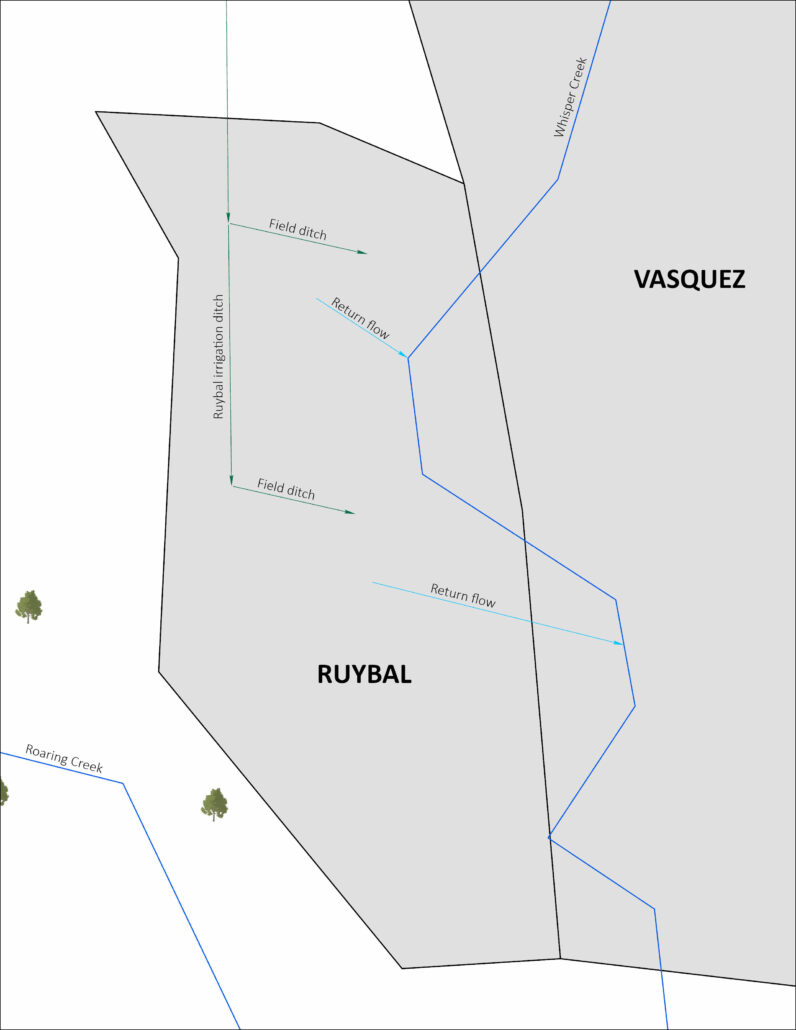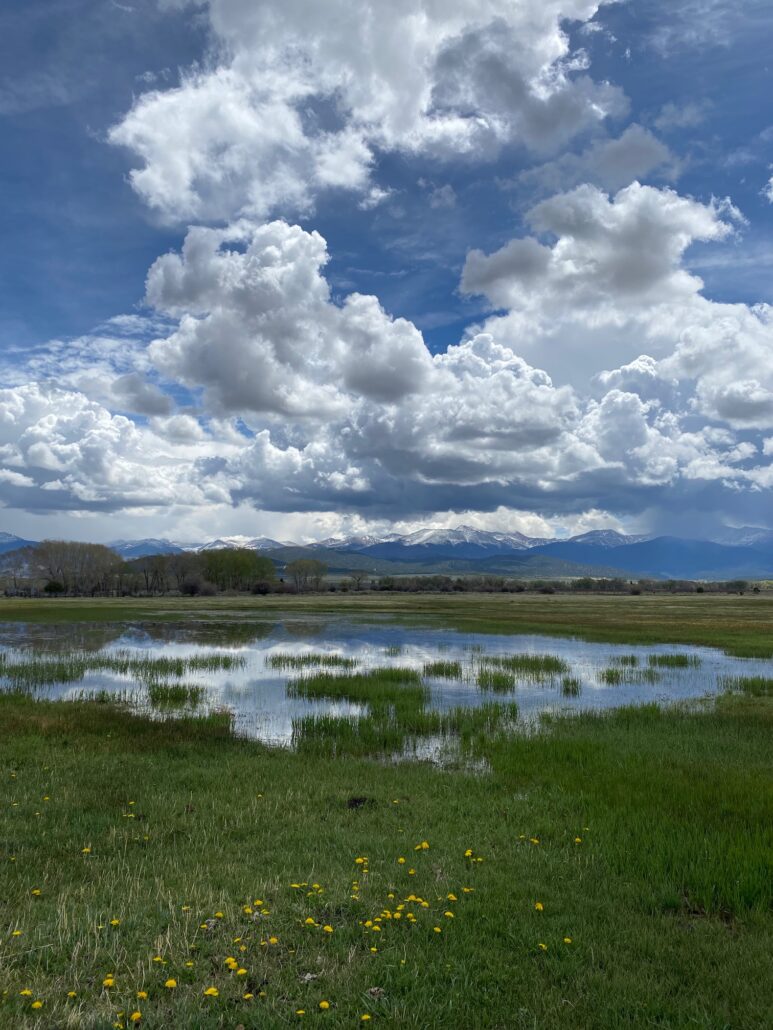You know the old phrase: Whiskey is for drinking; water is for fighting over. Over the two years that I’ve now been in the San Luis Valley (SLV) of Colorado, I’ve heard a lot of stories that recall that phrase. Stories of family members who no longer speak due to disagreements on irrigation strategies, landowners who’ve been shot by trespassers hoping to steal water under cover of night, ranchers on their fifth year of a water court case due to a neighbor dispute. This story, however, is not one of those. It’s one of cooperation, communication, and mutual respect.
To set the stage, let’s start with some context:
- Two adjacent properties: The Vasquez place and the smaller Ruybal place (see Map 1 below).
- Both properties are located on Whisper Creek; the Vasquez property has more of the creek channel than the Ruybal place.
- Both properties are located below Simpson Reservoir. This means that the flows in Whisper Creek are entirely determined by releases from the reservoir (they’re not “natural” creek flows).
- Both properties are located upstream of the confluence between Whisper Creek and the larger Roaring Creek.
- The Vasquezes make a living through cattle grazing and an angling guide business.
- Ruybal makes a living through cattle grazing and hay production.

Map 1
With me so far? Only a few more pieces of context to set the stage.
- The diversion structure that sends Whisper Creek water down an irrigation ditch to Mr. Ruybal’s property is located on the Vasquez property (see Map 2). Mr. Ruybal has easement to this structure, meaning he can legally enter the Vasquez place anytime he needs for the purposes of managing his structure.
- Ruybal has the legal water right to take a maximum of 4 cubic feet per second (CFS) out of Whisper Creek.
- From his primary irrigation ditch, Mr. Ruybal irrigates his pasture. The tailwaters from this irrigation return to Whisper Creek near the bottom of both properties.

Map 2
Now, let’s get into it.
Mr. Ruybal’s diversion structure (the yellow dot on Map 2) is in bad shape. The structure is set too high and, given the position of the ditch channel relative to where Whisper Creek is deepest, Mr. Ruybal can only get his full 4 CFS allocation when flows in the creek are 10 CFS or above. Remember, creek flows are entirely determined by Simpson Reservoir; and they can send 20 CFS down on Monday and 3 CFS down on Tuesday with seemingly no rhyme or reason. Rain sometimes supplements, but not nearly enough to make a difference.
I had been working with the Vasquezes for a few months on fish habitat projects when Mr. Ruybal called asking if I could help him get his diversion structure replaced. Of course, I was interested in helping him. However, what happens to the Vasquezes and their fish habitat if Mr. Ruybal, with a new and fully functional diversion structure, pulls his whole allocation (4 CFS) when there’s only 5 CFS in the creek? Or what if Mr. Ruybal wants as much of his allocation as he can get on a day when there’s only 3 CFS in Whisper Creek? Replacing that diversion headgate would potentially give Mr. Ruybal the power to “sweep the creek”; AKA, completely dry it up downstream of his diversion.
You may be thinking, “Mr. Ruybal would be hurting all the downstream water users, not just the Vasquezes!” In most cases, you’d be right. However, it’s only the Vasquezes and Mr. Ruybal with water rights on Whisper Creek, everyone else has water rights from Roaring Creek.
Plus, Mr. Ruybal was interested in enhancing wetland habitats on his property. For us in the SLV, one of the most effective ways to enhance wetlands is to slow the movement of water across a landscape, allowing it to seep in, saturate the soils, and support wetland vegetation. As shown on Map 3 – if we slow that water spreading across Mr. Ruybal’s place via his field ditches, then we slow the pace and potentially reduce the amount of water reentering Whisper Creek through the return flow channels (these are just natural low-lying areas on the land that flow back to the creek). Consequently, in the pursuit of habitat projects, Mr. Ruybal also has the power to minimize water supporting downstream fish habitats on the Vasquez place.

Map 3
This is the part of the story where things could start to get bad, voices could start to get raised, and I could get stuck in the middle between two potentially feuding neighbors. Luckily, however, the Vasquezes and Mr. Ruybal have always had a great relationship. When I told Mr. Ruybal that we may want to involve the Vasquezes in discussions around his diversion replacement and wetland projects, right away he said “of course!”. And when I told the Vasquezes that Mr. Ruybal was looking to replace his diversion headgate, they said “it’s about time! That thing hasn’t worked for him for years”. We had two parties willing to work with each other over potentially conflicting interests.
We sat down at the Natural Resources Conservation Service (NRCS) office with a contact from Trout Unlimited and we started to brainstorm. Could Mr. Ruybal and the Vasquezes sign an agreement through which Mr. Ruybal would be obligated to leave at least 4 CFS in the creek? Maybe no one needs to sign anything, it could just be a handshake agreement? Hang on, how much water do the fish populations in Whisper Creek need, at minimum, to survive? Well, when does Mr. Ruybal really need his water? After all, he picks up a lot of tailwaters from his neighbors on the other side. And then how can we enhance wetlands without stopping tailwater returns?
Then came a key question: isn’t Simpson Reservoir supposed to be “passing inflow” for Whisper Creek? The creek, fed by snowmelt, enters the reservoir on its uphill side. Technically, Simpson Reservoir is supposed to let out the same amount of Whisper Creek water that flows in (if Whisper Creek is running at 6 CFS on Monday, then 6 CFS comes out of Simpson on Monday; if Whisper Creek is running 10 CFS on Tuesday, then Simpson releases 10 CFS on Tuesday). Mr. Vasquez Sr. thought about this and responded that, in a high-water year like this one, there’s no way Whisper Creek would only be running 6 CFS like it was the day we met.
It seems we needed to talk to Simpson Reservoir before we could go much further on the diversion structure discussion, and this project conundrum is still ongoing. The wetland enhancement, return flow issue is looking easier to resolve. We can add check structures (mini dams) to Mr. Ruybals’s irrigation ditch to encourage the slowing and lateral saturation of his ditch water; we can help him get more bang for his water buck without necessarily using more.
It’s lucky I met the Vasquezes first in this scenario. Had I not, I may have launched in to helping Mr. Ruybal without considering the impact that his projects could have on his neighbor. This situation, though ongoing, has already taught me to explore neighbor collaborations and to encourage mutual benefits.
It’s also lucky that these neighbors are deeply respectful of one another, as that’s not always the case. They each understand the interests of the other and, throughout these conversations, have advocated for their needs without trivializing the needs of the other. There’s another component here for which both the Vasquezes and Mr. Ruybal have deep respect, and that’s Whisper Creek. Where these landowners live, there’s a particularly acute sense of respect for water resources, the greatest I’ve yet experienced in the SLV. They want to see the creek healthy and are willing to contribute to that end.
“I want to make something clear,” Mr. Ruybal said during that office meeting, “I do not want to sweep the creek. I don’t want to do that to you guys, I don’t want to do that to the creek.”

Irrigation-supported wetland in the SLV
NOTE: to maintain privacy of landowners, all names (property owners, creeks, etc.) have been changed to a randomly selected alternative.
 Anna Greenberg is a Private Lands Wildlife Biologist based in Alamosa, CO. CLICK HERE to learn more about the stewardship team!
Anna Greenberg is a Private Lands Wildlife Biologist based in Alamosa, CO. CLICK HERE to learn more about the stewardship team!


